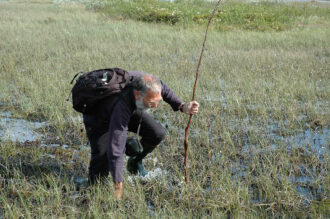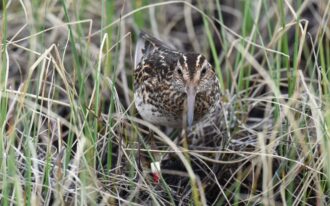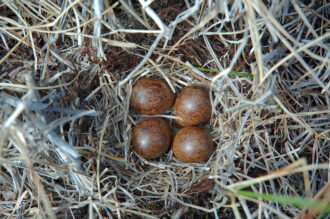Spotlight: A 30-year effort to study an elusive bird
by Deborah Buehler originally published in Wader Study 129(3)
Spotlight: A 30-year effort to study an elusive bird
The ground gives beneath your feet and you know you have to stop. The wetland surrounding you is also known as a mire, a word that gives fitting connotations of sinking and getting stuck. You look at the bird through binoculars, not daring to go further. It is a small sandpiper with short legs and a long, broad bill with a downturned tip. The English name for this bird is, aptly, Broad-billed Sandpiper. The bird’s Norwegian name is “fjellmyrløper”, which translates to “mountain mire runner”. Now you know why. Instead of flying, it runs through the grass-like sedges ahead of you, almost completely camouflaged. You were lucky to spot it. It probably has a nest out there in that floating vegetation, but you know that going further would not be safe for you or the bird you are trying to study.
Given the difficulty of even seeing these elusive birds, it’s no surprise that Broad-billed Sandpipers Calidris falcinellus are not well-studied. Yet, in this issue of Wader Study there are two papers, by the same team of researchers, on this species. One, by Robert Rae and colleagues describes the breeding ecology of these birds.1 The other by Brett Sandercock and colleagues focuses on the adult birds’ physical description and annual survival.2 Both refer to a long-term study that has been in place for nearly 30 years.
When the researchers began the study in 1993 the world was a different place. As they established the study site, Nelson Mandela was elected President of South Africa in the country’s first multi-racial elections. When they began to capture, and ring incubating birds eBay was launched. No one “googled” anything and technologies like social media and smart phones were more than a decade away. Yet over all this time, the researchers were walking through the mires, studying Broad-billed Sandpipers.
Broad-billed Sandpipers Calidris falcinellus breed in the subarctic taiga biome and can be divided into two distinct populations: a European subspecies breeding in Fennoscandia (Finland, Norway, Sweden and part of Russia), and an Asian subspecies breeding in central and eastern Russia. Globally, the species has a broad geographic range and a large population size, so it is listed as a species of Least Concern by BirdLife International; however, the population in Europe is decreasing and its conservation status is uncertain.
The researchers set up their long-term study site in the wetlands near Kautokeino, Finnmark in northern Norway, focusing on the European subspecies. Finnmark is situated at the northernmost part of continental Europe, where the Norwegian coastline swings eastward and “East meets West” in terms of geography, culture, and the natural environment.3 Though national bird surveys take place in this region, there are few records of nesting Broad-billed Sandpipers and no demographic data from breeding populations. Traditional survey methods like counting all birds seen or heard in a standard spot (point counts) or walking in a straight line (line transects) tend to overlook the presence of these camouflaged and secretive birds. 4
To remedy this problem, Rae and colleagues began to collect preliminary data in 1993 in order to develop a method to find and study these birds. As expected, nests and incubating birds were difficult to locate. Not only are Broad-billed Sandpipers secretive and solitary, they also “sit tightly,” which means that they are not easily startled (flushed) from their nests when disturbed. Some birds sat tight on their nests even when a person was standing over them. Therefore, each area of mire was searched by walking over it in a meandering route (in contrast to a line transect) to cover all potentially suitable nesting habitat
Once a study area was established, the researchers found as many birds and nests as possible, though some nests had to be monitored from a distance of several metres because they could not be reached safely for the observer or the nest contents. Starting in 1995, Rae and colleagues began to capture incubating adults in nests that could be approached, by laying a mist net over the nest when the adult was sitting on eggs or chicks. The researchers did not trap adults on days with rain or high winds that could chill the eggs while the parent was off the nest and did not observe any cases of nest desertion due to catching birds. Once a bird was captured, aspects of the bird’s body size (biometrics) were measured and the bird was marked with a numbered metal ring and a unique combination of colour rings. Colour-ringing allowed the birds to be recognized (re-sighted) when surveys were conducted in later years, creating encounter histories for each individual bird. Within the encounter history, each year was coded as 1 = captured or re-sighted on the study area, or 0 = not detected during the breeding season.
The researchers used this study protocol every year from 1995-2019 to survey 10-14 days in the 3-week period between 15 June and 8 July. From 2000-2019, they further mapped local conditions around the nest sites (in later years using GPS coordinates) so that the same areas could be checked in subsequent years to locate pairs reusing the same location. From 2009-2019, they conducted intensive monitoring with experienced observers returning to all sites two or more times during the incubation period to estimate nest survival.
All those years of fieldwork paid off. Rae and colleagues found a total of 173 Broad-billed Sandpiper nests from 2000-2019, with an average of 8 per year, but varying between 2-16. Nests were typically set in a shallow depression (scrape) on a tussock (tuft) of vegetation or mossy hummock and lined with dry dead sedge. All of the nests were located in or on the edge of floating vegetation within the mires and only 5-10 cm above the water level. No other bird species was found nesting in this way or in these habitats. The birds were also very faithful to their nest site. Of the breeding birds that returned in subsequent years, 97% nested in the same mire and many pairs reused the same nest scrape.
The average date for egg laying in years 2009-2019 was 10 June and varied between 1-24 June. Rae and colleagues were able to check the contents of 156 nests and found that 94% of these had four eggs, which is typical in shorebirds. They were further able to monitor the fate of 91 nests and recorded six losses due to flooding, one to predation and one from an unknown cause. Like most shorebird species, the males mainly took care of hatched young. The strategy of nesting on floating vegetation resulted in high nest success and low predation rates but left the nests vulnerable to flooding. Nest placement has conservation implications, especially if rainstorms fueled by climate change cause water levels to rise rapidly, threatening breeding success.
Rae and colleagues ringed and re-sighted 119 Broad-billed Sandpipers during the breeding seasons of 1995-2019. They found annual survival rates that were typical for small-bodied waders. Estimated survival rates did not differ between the sexes, but were lower among first-year than older birds, and highest among previously marked birds that had returned to the study site at least once. Biometric measurements of body size showed that, like in most species of shorebirds, females are larger than males, and that in Broad-billed Sandpipers the difference in size is greatest for bill length. Bill length affects feeding behaviour (pecking and probing for food) and in other shorebird species, this sometimes leads to males and females using different habitats and sometimes even different latitudes in the non-breeding season. Testing whether this might also be true for Broad-billed Sandpipers will require studies of feeding ecology on the non-breeding grounds.
Finally, the researchers captured three birds that had been caught and ringed elsewhere during migration (foreign recaptures). They were able to compare biometric measurements from these birds with similar data from birds breeding in the study site. These data suggested that birds breeding in Norway are part of the same population as birds stopping in the Sivash in eastern Europe during spring migration.5 The stopover area in the Sivash is located in the contested Crimean Peninsula. When this study began, Crimea was part of Ukraine and early fieldwork in both Norway and Sivash were underway. Two decades later in 2014, while the work in the breeding areas continued, Russia annexed the Crimea. This past year (2022), the Sivash is again in the middle of a war zone and one wonders about the fate of the birds, and of colleagues on both sides of the conflict.
The Sivash is not the only part of the Broad-billed Sandpiper flyway under threat. The researchers point out that poorly-studied nonbreeding habitats are also vulnerable to expanding human development. Future work will focus on tracking birds with geolocators, tiny tags that record ambient light level (solar irradiance) to determine the bird’s location. The tracking tags will allow researchers to gather better data on which habitats are critical in the nonbreeding range and might even allow data collection to continue when a site becomes inaccessible for on-the-ground study.
Thirty years is a long time. The internet rose, the Twin Towers in New York fell, wars began and ceased, and through it all these researchers walked carefully through the mires of northern Norway studying small sandpipers with short legs and strange bills. Their persistence and long-standing international cooperation provide more than just data about a poorly-studied bird species. In an increasingly fast-paced and divided world, this type of collaboration provides hope.
1 Rae, R, S Rae, B. K. Sandercock & D. P. Whitfield. 2022. The breeding ecology of Broad-billed Sandpipers in northern Norway. Wader Study 129: 183–189.
2 Sandercock, B. K., R. Rae, S Rae, & D. P. Whitfield. 2022. Sexual size dimorphism, disassortative pairing, and annual survival of Broad-billed Sandpipers in northern Norway. Wader Study 129: 194–206.
3 Finmmark. (2022, December 19). In Wikipedia. https://en.wikipedia.org/wiki/Finnmark#:~:text=Situated%20at%20the%20northernmost%20part,of%20Saint%20Petersburg%20and%20Istanbul.
4 Hildén, O. 1981. Sources of error involved in the Finnish line-transect method. Studies in Avian Biology 6: 152-159.
5 Verkuil, Y., T.M. Van der Have, J. Van der Winden, G.O. Keijl, P.S. Ruiters, A. Koolhaas, A. Dekinga & Chernichko, II. 2006. Fast fuelling but light flight in Broad-billed Sandpipers Limicola falcinellus: stopover ecology at a final take-off site in spring (Sivash, Ukraine). Ibis 148: 211-220.
PDF of this article



